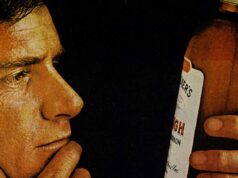My first taste of mezcal came on the heels of trying to force down a potent homemade batch of what was essentially botulism mixed with wood alcohol, or as I called it: “Mead, just like the fucking Vikings in Beowulf drank.”
After drinking enough of what would’ve been labeled Exhibit A had I kept at it, I needed a break from throwing up and was sufficiently tipsy to root through my parents’ closet until I found a box marked “HONEYMOON” in black marker.
They’d gone to Guadalajara and had apparently seen fit to buy every stereotypical souvenir they could lay their hands on. My sister had long ago gotten to the fifth of tequila with the sombrero twist-off (then refilled it with colored water), but there was still the bottle of mezcal with the worm at the bottom, which she had deemed too “grody” to drink.
I took the bottle to my room and cracked the seal. The first sip shocked me—it was as if I’d been struck by lightning. The second was less so. By the end of the night I was so rollicking drunk that I defiantly smashed the empty bottle against the porch (I’d come to regret that the next morning). What had begun as my first negative drunken experience transformed into my first positive drunken experience.
Back then mezcal was hard to find in liquor stores, especially if you were underage, so I had to rely on the occasional bottle brought back from an older friend who spent his weekends running amok between Tijuana tourist traps.
I don’t think most mezcal manufacturers expected gringos to actually drink the stuff once they got it home. The more brands I tried, the more I realized that there was an unevenness in taste. Some bottles tasted like vinegar and some like tear gas, with little middle ground. Some smelled vaguely sweet and turned out to be joke mezcal—bottles of sugar water mixed with cinnamon. Even some of the worms were fake—one was actually made of yarn and a button. Whoever made that craft worm is likely getting rich selling them on Etsy.
Even some of local drug cartels have gotten into the booze business, though most are choosing to invest their pesos in bunker-like Fentanyl factories high in the hills, intent on catching the next wave.
The only thing those bottles had in common were those poor, insidious novelty worms (real or unreal) lurking in the depths. Yet mezcal intrigued me. Even the lousiest-tasting bottles, a sort of greasy turpentine that burned the roof of my mouth and did something to my tongue that made it hard to talk the next day, were never enough to crush my dreams of one day waking up hungover, con la cruda, on a dirty Mexican sidewalk. (Spoiler alert: Dreams do come true! See 2013-2015.)
In college, I noticed that most of America’s standing inventory of mezcal came from the Spring Break resorts of Acapulco and Cancun or duty free shops at the airport. Once the bitchin’ wet T-shirt contests had faded into memory and the Panama Jack tank tops had been safely stowed for the long vodka winter, most of the bottles of mezcal would be gathering dust on a shelf.
It was either: “There’s a rad story that goes with that bottle,” or “I’m never going to drink it because worms are gross.” Mezcal bottles were like liquid lift tickets that stayed on a jacket long after the snow had melted.
Some proactive frat dudes bought into the myth that eating a mezcal worm, that ominous-looking, bloated souvenir of Old Mexico, would send you straight into a magical psychedelic bus trip with Neal Cassady and Carlos Castaneda. They were always disappointed and often protested by pouring the rest of the booze down the drain along with a litany of racial epithets as if that might hasten its departure. Going forward, they often pledged their allegiance to Jose Cuervo. Mezcal’s dimwitted brother, tequila, was getting more expensive, brash and rapey, while mezcal kept its mysterious outsider status.
Mezcal could have very well remained a footnote in the pantheon of bottled liquor if not for the cultural U-turn made in the 1990s when irony became emperor and authenticity became “cool,” right or wrong.
The “coolhunting” business became a real thing. Pabst Blue Ribbon started making a profit. Idiots began growing mustaches and wild beards as a reaction to their earlier shitty ideas. Everybody was trying to stay one step ahead of themselves. Somebody picked up a bottle of mezcal and actually tasted instead of guzzling it. Word spread faster than herpes during a gap-year reiki class. American hipsters, already the world masters at appropriation, added the little known liquor to their arsenal of hip.
And just like that, the Mezcal Worms appeared, and I’m not talking about the ones at the bottom of the bottles (actually they were and always had been caterpillars, but truth has always been the first thing to go during war and marketing campaigns). These Worms wore Tom Ford suits and had corner offices in the marketing departments of multinational beverage conglomerates who were buying up mezcal companies as fast as they could find them.
Like artisanal porridge shops and urban lumberjack supply depots, mezcal boomed. And why not? With an aura of cultural authenticity no longer found in tequila, there was a ready market willing to overpay for it. Good mezcal was a labor of love and made in true micro-batches. Like any decent whore, the nascent U.S. mezcal market demanded the illusion of love with the spread-eagle over-supply found on floor mattresses behind turnstiles. While the battle still rages, greed is kicking authenticity’s ass. Again.
The best mezcal I’ve ever had came from a stranger’s red plastic gas can marked only with a piece of masking tape listing a name and a local 951 (Oaxaca) phone number in case you wanted more. It tasted like liquid fire filtered through a set of dirty hostel sheets. It was delicious and real, distilled from the pinas of wild agave, not cultivated on a mega-farm with Monsanto products.
Now that columns have appeared in the Wall Street Journal with tasting notes (“smoky and well worth the $200 price tag”), or in Men’s Health (“15 Mescals to Buy Now”), as though they’re liquid mutual funds, let the buyer beware. Obtaining a license to export distilled spirits like mezcal to the United States is a complicated, time consuming and very expensive proposition. One that true mezcal farmers have little time or money for.
I have a friend who finds it much more profitable to run mezcal like it was Prohibition. He has it shipped on boats from Puerto Escondido (the closest coastal port town here in Oaxaca, and the same embarcadero where Oaxacan drugs leave the local market) all the way up to San Francisco, where he supplies many of the bars with genuine, small batch products at exorbitant prices. A bottle that might cost $5 here in southern Mexico can fetch more than $200. Subtract the price of bribing underpaid officials to look the other way and the time and expense of sailing up the California coast from southern Mexico, and he still comes out on top. Way on top. He recently purchased two high-end restaurants here in Oaxaca, gave them dumb hipster names and jacked up the price of a hamburger to $8 American.
Even some of local drug cartels have gotten into the booze business, though most are choosing to invest their pesos in bunker-like Fentanyl factories high in the hills, intent on catching the next wave. (Why employ an army of workers to manage easily identified poppy fields when you can crank your product out of a factory?)
The local mezcaleros have picked up some of the slack, providing legal, low-paying jobs for countless jimadors and campesinos who once wielded multi-blade knives collecting bricks of opium in the tropical sun. The Oaxacan Cartel isn’t at war with anybody (right now), so violence is actually at a low level. (Though occasionally somebody has to be made an example of and have their decapitated body hung in the middle of the public square, their genitals stuffed into their mouth.)
Most importantly though, these small batch mezcal makers are creating delicious booze.
But the Mezcal Worms on both sides of the border, with their deep pockets, have different plans for the future of the industry. That’s why this year’s Internacional Feria de Mezcal in Oaxaca was the most important fair in a decade. The fair is billed as part of the colorful cultural life-swirl of radiant indigenous energy called the Guelaguetza Celebration. It’s famous for the pageantry of color and tradition, as well as being the only time of the year you can go anywhere near the auditorium on the hill overlooking the city without being mugged by a guy with a machete. Admission is a scant 40 pesos (about $2.50) for all the mezcal you can handle. I’ve gotten my money’s worth a thousand times over and usually attend the fair on multiple nights (it lasts about a week and a half ) for the past three years and every year have gotten so blotto that I’ve lost four sets of keys, two wallets, and even had a pair of sneakers stolen off my feet.
But this year was more troubling because the tourists weren’t there. It wasn’t as crowded as it normally is and many of the mezcal producers said they had recently made large investments on their farms that weren’t paying off. The dip in tourism has to do with the striking teachers blocking the roads in and out of Oaxaca as well as the local airport. Oaxaca is a diverse state anywhere from 3.5 to 10 hours outside of Mexico City. There are a limited number of direct flights from the U.S., so for most a trip involves a long bus ride. You really have to want to go to Oaxaca to get here. Even more so, you have to really want to go to the beaches of Oaxaca. Though only a 120 or so miles away, the transit involves either hitching a ride in a van so full of dope smoke it stains your clothes or by sitting on a commercial bus for 10 hours, navigating one of the most curvy, dangerous mountain roads in the country. There are sometimes bandits and always topes, a kind of speed bump that resembles a table and must be taken at 2 mph so the bus doesn’t break.
Obviously, Modern Drunkard isn’t a forum to discuss politics and the merits of their grievances or the tactics of the striking teachers, but when tourists are scared away or otherwise prevented from coming to Oaxaca and spending their dough on that lovely fermented agave nectar, debt-ridden farmers can get desperate and do desperate things, especially when it comes time to pay the bills. Tourism is virtually the only (legal) industry here in Oaxaca. Most of the local money comes in remittances from family members working in the states. The minimum wage here, though recently raised, still sits at a shameful 70 some odd pesos per day. Not per hour. Per day. A day’s work for a campesino can run from 8 am to 8 pm for roughly $4.25.
What happens to the small mezcal producers in an off and uncertain year? While they do sell aged mezcal, it’s not appreciably better after resting in French oak barrels for 12 years. When the tourists don’t come, a Worm can buy up a farmer’s excess production and that of his neighbor and his neighbor’s neighbor.
The Worm then mixes it all together and sells it under a cool brand name—more thought is likely put into the logo than into the logistics of export. The Mezcal Worms re-christen the drink, pour it into cool-looking hand-blown glass bottles with colorful Aztec or Mayan drawings, or Dia de los Muertos clip art then sell it as premium mezcal in the U.S. for huge profits.
Like their Big Pharma counterparts who jack up the prices of Epi-pens and AIDs drugs while giving themselves huge bonuses, these güero gusanos are full-fledged mezcal touts, company men and women who carry their agave hard-ons from one U.S. bar to another spreading the cool. These are some of the same people who pushed tequila prices into the stratosphere.
Yes, I know how capitalism works. I know how rape works, too, but it doesn’t mean I want to sit back and watch it happen. When P. Diddy, or rather, Combs Wine & Spirits, buys your company to market it in the “luxury lifestyle marketplace” for $1000 a bottle, as he did with Deleon Tequila, the game is over.
I’m looking at a wild agave plant right now. It looks regal, sitting in a patch of orange-colored dirt as though the earth had suddenly frozen while exploding high into the sky. I’m told that soon there will be mega mega-farms of mezcal agave like there are for the blue agave plant needed to make tequila. The day a shot of mezcal is sold for $50 and guzzled like a body shot from between a stripper’s fake tits may be a red-letter day for the new breed of Agave Worms, but it will be a sad one for Mexico and for mezcal.
Well, there’s always pulque.










